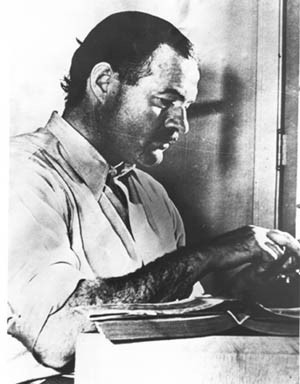Ernest Hemingway
Author

1899 - 1961
Inducted in 1987
Biography
This preeminent literary figure of the 20th century moved to Key West in 1928, living there periodically through 1940. Hemmingway wrote all or part of his most famous works including A Farewell to Arms, For Whom the Bell Tolls, To Have and Have Not and The Snows of Kilimanjaro in Key West. In 1954, he became only the fifth American to receive the Nobel Prize for Literature.
Born Ernest Miller Hemingway in Oak Park, Illinois, Hemingway grew up in an affluent home (his father was a physician and his mother a professional opera singer) where he was exposed to art, literature, music and also the great outdoors. At the family's lake house in Michigan, the athletic, outdoorsy Hemingway developed a passion for hunting and fishing.
After graduation from high school in 1917, Hemingway decided to forego college and become a cub reporter for The Kansas City Star. He worked there for only six months, but the newspaper style of writing–concise and austere–heavily influenced all of his writings for the rest of his life.
Displaying a restlessness that would mark a seemingly larger-than-life career, in the waning months of World War I Hemingway volunteered as an ambulance driver for the Red Cross in Europe. Badly wounded on the Italian Front, he spent six months recuperating in a Milan hospital before returning, at age 19, to the U.S.
Hemingway's interest in journalism eventually carried him to Chicago in 1920, where he worked as an associate editor of the monthly journal Cooperative Commonwealth. There he befriended Sherwood Anderson, already a respected novelist. Shortly thereafter, Hemingway met and married his first (of four) wives, Elizabeth H. Richardson. In 1921, the couple left for Europe, Hemingway having accepted a post as foreign correspondent for The Toronto Star. Anderson persuaded Hemingway to set up shop in Paris, a decision that proved remarkably fortuitous for a young newspaperman who yearned to be a novelist.
In Paris, Hemingway met many of the leading figures of the so-called "Lost Generation," a term originated by Gertrude Stein, among the most notable European writers who took Hemingway under their wings. Other Parisian luminaries that Hemingway spent much time with included Ezra Pound, James Joyce, Pablo Picasso, Joan Miro and F. Scott Fitzgerald. After a brief return to Toronto in 1924, Hemingway and his family (son Jack was born in Toronto) returned to Paris, where he finished his first novel (of seven). The Sun Also Rises (Scribner's, 1926), a story built around a group of expatriates living in Paris, made Hemingway famous.
In 1928, Hemingway was divorced, remarried (this time to Pauline Pfieffer, a fashion writer) and–at the suggestion of novelist and friend John Dos Passos–moving to Key West, where he fell in love with the island's lush tropical greenery and seclusion. He would spend an eventful and highly productive decade there before moving to Cuba (with his third wife Martha Gellhorn, a journalist and war correspondent) in 1940.
From 1941 through the mid-1950s, Hemingway led an astonishingly colorful and dramatic life. The period was punctuated by his frequent forays overseas as a war correspondent (he covered the Spanish Civil War as a champion of the losing rebel side) and World War II (where his extra-curricular exploits at the front almost got him court-martialed but later earned him a Bronze Star); a second African safari (where he and his last wife, Mary Welsh, narrowly escaped death in two plane crashes in two days); his winning the world's top literary prizes (the Pulitzer Prize in 1953 for the novel The Old Man and the Sea) and the 1954 Nobel Prize for Literature) and two more failed marriages.
In 1959, Hemingway and Welsh bought a home in Ketchum, Idaho. Suffering from depression and failing health–a casualty of his numerous serious injuries and a lifelong habit of hard drinking–in July 1961 Hemingway committed suicide.
Hemingway's legacy as a titan of modern American literature is immortalized by two nonprofit foundations (The Hemingway Oak Park Foundation and the Hemingway Society); a national literary prize in his name; a number of formal memorials and other tributes; more than a dozen biographies; numerous Hemingway studies programs on campuses around the world and at least five museums.
Hemingway's Florida days are commemorated by the Ernest Hemingway Home and Museum, located at the home he owned on Whitehead Street in Key West. The attraction annually draws thousands of visitors from around the world, as does the annual Hemingway Days celebration, held in Key West during the week of his birthday in July.

